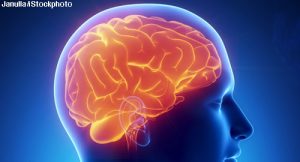 SAN DIEGO—Functional magnetic resonance imaging (fMRI), which uses magnetic properties of oxygenated and deoxygenated blood as an indirect measure of neuronal activity, is helping researchers understand how disease activity in lupus affects brain function, said an expert in a session at ACR Convergence 2023.
SAN DIEGO—Functional magnetic resonance imaging (fMRI), which uses magnetic properties of oxygenated and deoxygenated blood as an indirect measure of neuronal activity, is helping researchers understand how disease activity in lupus affects brain function, said an expert in a session at ACR Convergence 2023.
This session covered the latest findings on fMRI, which is giving researchers a look at the brain fog often described by patients with lupus. Experts also presented a description of the latest research into the role of microglia in neuropsychiatric lupus.
New Insights
Ian Bruce, MD, professor of rheumatology and director of the National Institute for Health and Care Research (NIHR) Manchester Biomedical Research Center, University of Manchester, U.K., said the field is making strides in an area that has not been properly addressed for lupus.
“Up to 80% of patients [with lupus] get some kind of neuropsychiatric involvement at some point,” he said. This involvement is most commonly headache, mood disorders and cognitive dysfunction. Researchers have been attempting to measure cognitive dysfunction in lupus more uniformly and define phenotypes so patients can experience improvement in their cognitive symptoms.
Using the Cambridge Neuropsychological Test Automated Battery (CANTAB), researchers found that patients with lupus have lower sustained attention tendency and take longer on processes involving emotion than healthy controls. In this study, researchers used fMRI to assess patients’ attention, working memory and face emotion recognition. When compared with healthy controls, patients with lupus had reduced attention that was associated with interleukin (IL) 6 levels and disease activity on the British Isles Lupus Assessment Group (BILAG) index.1
This research also found reduced performance in the working memory of patients with lupus than controls. This reduction was linked with mood, the inflammation-associated adhesion protein VCAM-1 and the Systemic Lupus International Collaborating Clinics (SLICC) damage index. Patients with lupus were also slower to respond to faces demonstrating sadness, and this finding was linked to the SLICC damage index and disease duration.2
Researchers also looked at the default mode network—the brain network that stays busy while someone is not actively engaged in tasks, such as when daydreaming. This network is suppressed or attenuated when concentrating on a task. They found that patients with lupus experiencing flare have much less attenuation of the default mode network during a task than those with stable disease.1,2
In another aspect of this study, they examined functional connectivity between brain regions when patients were in a resting state. They found no difference in this connectivity for patients with flare compared with non-flare patients; however, they found lower levels for patients with lupus overall when compared with controls. Additionally, they found that mood was a significant predictor of this connectivity but accounted for only about 20% of the difference.1,2
Dr. Bruce said this functional connectivity at rest may be an early marker of cognitive dysfunction in patients with lupus but work in this area is continuing.
“I think what we need to do is better elucidate the contribution of inflammation damage, medication and comorbidities to some of these regions of interest” in the brain, he said.
Microglia
Carla Cuda, PhD, assistant professor of medicine-rheumatology at Northwestern University Feinberg School of Medicine, Chicago, said there is growing research into the role of microglia, resident immune cells in the brain, that may help clarify the underlying causes of neuropsychiatric lupus.
“These cells really help to maintain the homeostasis of your brain and the function in your brain” through synaptic pruning, surveillance and phagocytosis, she said. “But some of these functions can go awry, and when that happens, [it] can lead to dyshomeostasis.”
In a neuro-lupus mouse model, Dr. Cuda and colleagues found that microglia are more activated and show increased uptake of synaptic material, compared with wild-type mice. They also found disease-associated microglia (DAM) gene expression in the microglia of this model, and that expression of these DAM signatures was linked with behavioral deficits in young mouse models.3
In other work, researchers have found that the sphingosine 1-phosphate-receptor modulator fingolimod reverses behavioral deficits in another model, possibly because it prevents the transition of microglia into a disease state. When fingolimod is administered, DAM-associated gene expression is suppressed.4
“Together, these discoveries are among the first to implicate DAM as a potentially pathogenic and not protective microglia subset in neuropsychiatric lupus,” says Dr. Cuda.
Thomas Collins is a freelance medical writer based in Florida.
References
- Barraclough M, McKie S, Parker B, et al. Altered cognitive function in systemic lupus erythematosus and associations with inflammation and functional and structural brain changes. Ann Rheum Dis. 2019 Jul;78(7):934–940.
- Barraclough M, McKie S, Parker B, et al. The effects of disease activity, inflammation, depression and cognitive fatigue on resting state fMRI in systemic lupus erythematosus. Rheumatology (Oxford). 2022 Apr 18;61(SI):SI39–SI47.
- Makinde HM, Winter DR, Procissi D, et al. A novel microglia-specific transcriptional signature correlates with behavioral deficits in neuropsychiatric lupus. Front Immunol. 2020 Feb 26:11:230.
- Mike EV, Makinde HM, Der E, et al. Neuropsychiatric systemic lupus erythematosus is dependent on sphingosine-1-phosphate signaling. Front Immunol. 2018 Sep 26:9:2189.

